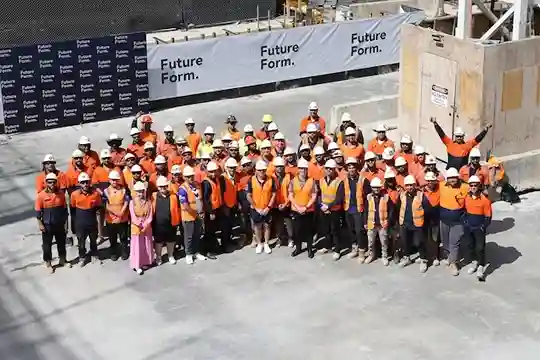Formwork Information | Future Form
Our guide below explains what a Formworker is and how they are critical to construction projects.
What is a formworker?
Formworkers are skilled tradespeople who build, install and dismantle the structures that shape poured concrete. Their work ensures that formwork holds the correct dimensions, supports design loads and achieves a precise finish.
Formworkers collaborate closely with steel fixers and concreters to deliver safe, efficient results on site. Their skill, planning and accuracy are essential to every stage of construction.

What does a formworker do?
Formworkers are people who put together prefabricated structures (forms) made of steel, heavy plastic, or wood. They normally transport heavy forms, spray them with oil to keep the concrete from sticking, secure these forms with iron rods, and insert steel reinforcement to strengthen the concrete. In addition, formwork contractors strip the forms, clean them, and prepare them for the next project once the concrete has been set.
Formwork contractors also build new forms on top of previously poured concrete, like high-rise buildings and tall structures. It is known as slip-forming and involves a repetitive process of forming, pouring, forming, and pouring.
Formwork Contractors can also do the following:
– Be skilled at measuring and cutting (because premade form sizes do not always correspond to the exact structure dimensions).
– Building fillers to fill gaps.
– Connect prefabricated units for large sections of high-rise or civil projects and position reinforcement for concrete pours.
– Reading and interpreting work plans and blueprints.
Why is the role of formworkers so important in the Australian construction industry?
– Formwork enables construction managers to provide precise on-time mobilization and demobilization of formwork resources, thereby increasing project efficiency and resource utilization.
– Formwork provides a high level of structural safety by providing solutions against all superimposed loads, resulting in extremely safe and long-lasting structures.
– Formwork provides appropriate access and working platforms, significantly increasing worker safety during construction.
– Formwork significantly reduces project costs and timelines by reducing the floor-to-floor construction cycle time, allowing more projects to meet their budgetary requirements.
– Since formwork is directly related to the surface finishing of the concrete structure, the higher the quality of formwork used, the higher the quality of surface finishing.
What does a typical process of a team of formworkers building the foundation of your building looks like?
A highly skilled team of formwork contractors will be handy to help you create a strong foundation for your building. An example of a procedure they follow is highlighted below!
– The first thing to do is make a suitable site selection. Investigating the soil condition of your land is key. Often, special treatment is required if the soil lacks the desired load-carrying capacity because it can weaken the building foundation after some time. Before formwork contractors embark on their work, they must consult with a structural engineer or Geo-technical Consultant to help them establish the condition of your soil.
– When formwork contractors reach the job site, they go over the construction plans, which may have been prepared with the help of structural engineers, to ensure that they are sound. Formwork contractors usually possess knowledge of structural and concrete elements such as rebar, the building code, and industry practices and standards. Forms must safely withstand the weight of concrete and hold it firmly in place while it hardens. Forms must also provide enough thickness and shape to comply with the code.
– Then, the formwork contractors begin the process of site preparation. Excavating, laying gravel and other drainages, and carefully measuring before beginning work are all examples of site preparation activities that formworkers perform. They can install posts to hold the forms, which can be made of various materials.
– Formwork contractors must also mark all pillars and trench excavation lines. They should excavate as much as needed while adhering to size, shape, alignment, and levels. Then, the formworkers should begin the process of compaction of the excavated soil top layer and the addition of a layer of Brick flat soling on top. After this, they should lay a thin layer (about 50 to 75 mm thick) of lean concrete at least 6 inches larger than the footing’s size. Doing this provides your building foundation with a flat and firm base for laying Reinforced Cement Concrete (RCC) footing work and retaining the moisture content of footing concrete with zero soil soaking.
– The Wooden Formwork is the next step in constructing your building foundation. The formwork should be made to fit the size of the footing and be sufficiently rigid to prevent displacement during the placement of reinforcement bars and the laying and compacting of the concrete. They must properly seal the gap between the formwork to prevent slurry loss from the concrete.
– Reinforcement Steel (Rebar) work is the next critical step in constructing your building’s foundation. The rebar must be cut and bent per the footing’s bar bending schedule to avoid waste of steel material. The placement and fixing of rebar must be done correctly with adequate concrete cover blocks to avoid rebar displacement during the concrete pour.
– If everything is in place, the formwork contractors move to the final step of constructing your building foundation: pouring concrete into the footing. The concrete must meet the approved design grade. For quality control, the workability of the concrete should be checked by the formworkers regularly during the concreting process. They should also take a suitable number of concrete test cubes to check the crushing strength of the test cubes at 7 and 28 days, respectively. The concrete should be well compacted and properly cured.
Final takeaway
Formwork contractors play a vital role in construction, ensuring structures remain strong, precise, and capable of withstanding heavy concrete loads. In Australia, permanent formwork has been relied upon for centuries as a cost-effective and efficient solution for stability. From foundations and residential walls to civil engineering projects and skyscrapers, trusted formwork solutions Sydney construction companies depend on are essential. Without these professionals, modern building projects would lack the strength to succeed.
TESTIMONIALS
What Our Clients Say
Professional formwork subcontractor, great service and quality of works delivered by the team.
FFGA has always shown an immaculate level of workmanship throughout all projects.
Very professional Safety-centric company that is setting the standards.










